For the third year in a row, we conducted two separate spring field trips to the Eureka Prospect and Columbia Mine near Marion in Crittenden County, Kentucky. You can see my reports of the previous trips by clicking on the following links: March 2008 Field Trip, May 2008 Field Trip, March 2009 Field Trip and April 2009 Field Trip.
The renowned Ben E. Clement Mineral Museum in downtown Marion was our host. As I have stated before, the Clement contains the world's largest collection of fluorite; an untold number of specimens that would be the envy of any collector and even the Smithsonian. In addition to guided tours of the museum, the Clement conducts fee-based field trips to local fluorite mines and prospects, including the Columbia Mine and Eureka Prospect. Be sure to check the museum's web site for more information (see above link).
Knowing that there are many other McRockers who are enthusiastic about the prospect of collecting at the Eureka and Columbia and wanting to continue to support the Clement, James Johnson and I arranged to conduct a three day field trip for April 2-4, 2010. Since first-hand knowledge of current collecting conditions is necessary before I will lead a large group to any location, we contracted a track hoe operator and invited a handful of experienced rockhound friends to expose fresh rock the weekend prior to the McRocks group dig.
Machine Dig
March 27-28, 2009
(field pictures taken March 27th)
A total of 8 people (James Johnson, Everett Harrington, Celia Harrington, Ernie Walker, Jeff Deere, Bill Hayward, Phil Koble and Mike Streeter) were on hand for what was essentially an "exploratory" and "preparatory" machine dig. The costs for the track hoe, bulldozer, water pump and other miscellaneous equipment and services were split evenly between the participants. A machine dig of this sort can be a bit of a gamble because there is no way to guarantee we will recover anything worthwhile. But, "you can't win if you don't play" and just being in the woods rockhounding with the aid of a large machine is a hoot in itself and anything recovered was a bonus. After all, how often do most of us get to direct a monster track hoe to dig down and remove many tons of soil and rock from precisely where you point - wheeeeee! I wish I could invite everyone to one of our machine digs, but since safety is paramount, it is not a good idea to have too many rockhounds, especially children, bounding about when a large machine is running. Everyone who participated in this machine dig is highly experienced and thus familiar with the many dangers and behaved accordingly while I supervised the track hoe operations.
James and I were first (and second) to arrive just after sunrise Saturday morning. After looking around, we realized that it was a darn good thing we had decided to perform a machine dig prior to the McRocks group field trip as there appeared to be slim pickings on the surface. The prior collecting season, extending from spring to late fall, had left relatively few decent rocks on the surface, so exposing fresh material would be necessary for the McRocks group's and subsequent rockhounds' success - at least that was our plan.

View of groundwater-filled old pit before machine dig
|
The machine dig, although cold, wet and very muddy on the 2nd day, turned out to be successful for both the participants and the McRocks group that followed. During the machine phase, we managed to expose and work significant subsurface mineral veins in bedrock and I made sure to create piles composed of what I surmised was specimen-rich overburden and used the less rich dirt and rock as backfill for the old pit - we "separated the wheat from the chaff", so to speak, kept track of what was what and prohibited the bullzozer operator from running over the "honey" piles to lessen the chance of any specimen damage therein. So, those who attended the subsequent McRocks group dig were able to find many excellent specimens in the piles or access the new pit to recover specimens. But rather than drone on about the two weekend events, I'll simply let the following pictures and captions speak for themselves.

Digging out vein and new pit

Checking rock in bottom of pit
| |

The guys checking for potential veins
as the machine digs back

Expert track hoe operator, Wayne, digging
benches on pit sides for safety
| |

Continuing to check for veins

Wide view showing old pit (foreground)
and start of new pit.
| |

Wide view showing new specimen-rich piles
(middle left in picture)
|
McRocks Group Dig
April 2-4, 2010
(field pictures taken April 2nd)
Chrissy, Opal and I made the long drive back to Marion to help lead the McRocks Group dig. It was good for me to have my whole immediate family there this time. Most everyone who made the wise decision to attend got muddy at some point during the weekend, but had big time fun!

Group Dig in Fluorite Pit
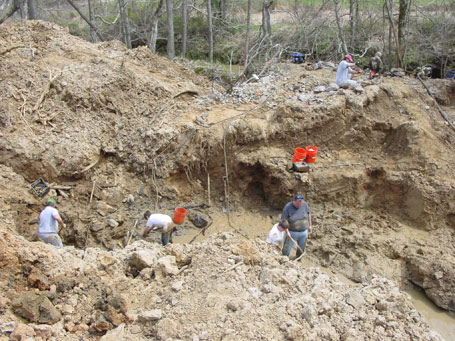
Group Dig in Fluorite Pit -
Side view from spoil piles
| |
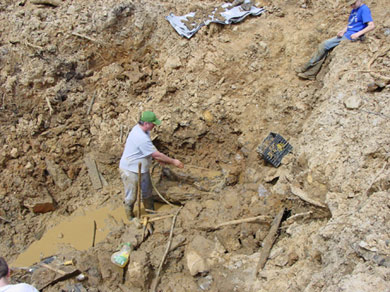
Robert Duncan working a vein
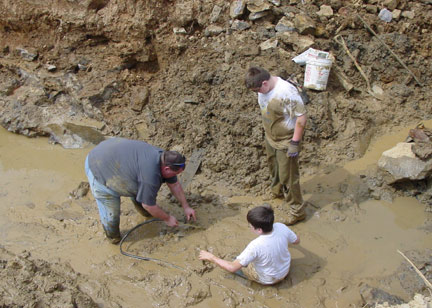
Jason, Justin & Michael Hefner
working the muddy pit
| |
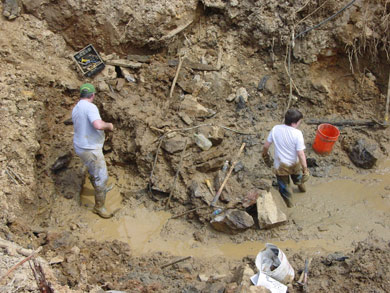
Close-up of pit showing mud, rock & veins
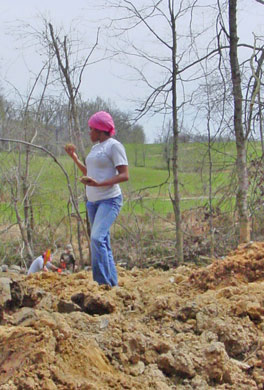
April Gibbs hunting the spoil piles
| |
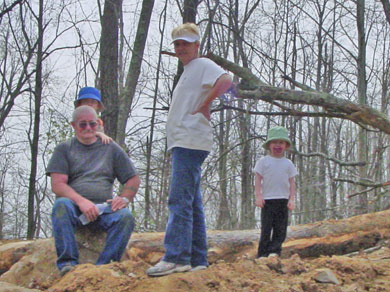
Philip & Linda Stancill & Grand kids
taking in the view
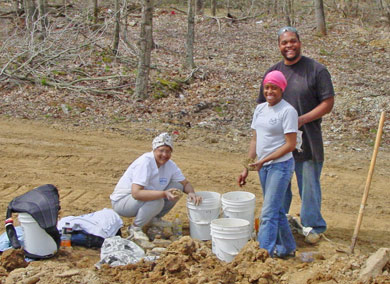
Linda, April & Steven Gibbs
| |
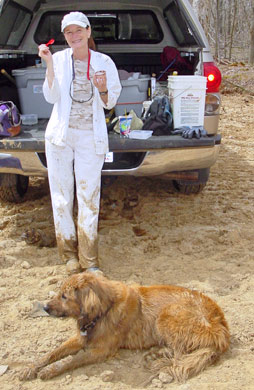
Chrissy & Opal Streeter

Christian & Keely Kohen
comparing finds
| |
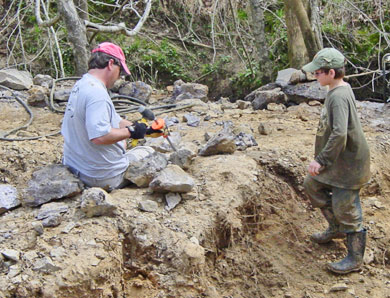
Brian & Christian Kohen
busting surface rocks
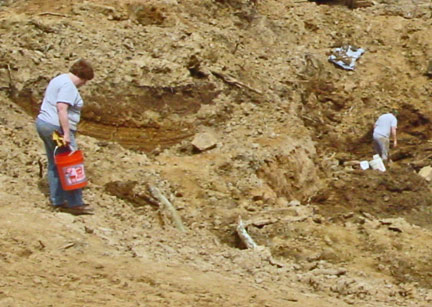
Bebe Buck surface collecting
| |
So, now you've seen the field portion of my report, but how about specimens you ask? The following page includes pictures of some of what we brought home - needless to say, we are pleased with the lot.
Thanks again to the Clement Museum's Bill Frazer, Tina Walker and BJ. You could not have treated us all better
Report continued . . . . . . .
Click Here for Next Page
CLICK THE LITTLE MINER TO RETURN TO THE FIELD TRIP PAGE





















